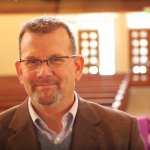The Road to the Future Runs through the Past:
How Worship Communicates and is Formed
by the Biblical Narrative and the Great Tradition
By Dr. James R. Hart, President
The Robert E. Webber Institute for Worship Studies
 Robert Webber wrote, “Worship does God’s story.” What does that mean, and why does it matter? If it does matter, how has God’s story formed the worship of God’s people over the past two thousand years? More to it, how has that worship formed God’s people into Christ-followers being “poured out for the life of the world?”
Robert Webber wrote, “Worship does God’s story.” What does that mean, and why does it matter? If it does matter, how has God’s story formed the worship of God’s people over the past two thousand years? More to it, how has that worship formed God’s people into Christ-followers being “poured out for the life of the world?”
Just as the historic creeds of the Church are biblical and theological summaries of what we have always believed as Christians, so worship is a biblical and theological summary of how God’s people are, and have always been, spiritually formed by God’s Word, enlivened, renewed and nourished by God’s presence and sent into the world on God’s mission. Worship is the Gospel proclaimed and embodied. The entire biblical narrative is summarized in the Gospel, which is the essential content of Christian worship. The Church father Athanasius defined the Gospel in this way, “The Son of God became the Son of Man, so the sons and daughters of men could become the sons and daughters of God.” This biblical definition of the Gospel is consistent with the unanimous witness of the Church fathers, that in Christ all of humanity has been taken up into the divine life of God. In fact, according to St. Paul, all of creation itself has been reconciled to God through Christ (2 Cor 5:19, Eph 1:9, 10 (recapitulation); Col 1:20). We do not become the “I AM,” or the ipsum esse subsistens, “the subsistent act of ‘to be’ itself,” as St. Thomas Aquinas referred to God. But we can become like him, transformed into his likeness revealed in Christ, empowered by the Holy Spirit.
The entirety of Christian worship and liturgy should be rooted in this Gospel. Bob Webber defined the gospel generally as God’s story of reconciliation of the entire created order through the work of Jesus Christ, his only Son. Webber’s definition of the gospel, informed by his study of the Church fathers, related to the “divinely authorized canonical story of the Triune God. This story—Creation, Incarnation, and Re-creation—was effected by Christ’s recapitulation of human history and summarized by the early Church in its Rules of Faith.”[1]
Back to my earlier question: how has God’s story formed God’s people? Here is a true, biblical and spiritual principle. Spiritual formation takes place only in the womb of the Church. And, worship is famously the source and summit of the spiritual life of the Church. Therefore, God’s people are formed most profoundly in worship emanating from the community of Mother Church.
Third century bishop and martyr St. Cyprian of Carthage wrote, “He cannot have God for his Father who has not the Church for his mother.” [Continue reading. . .]
[1] Robert E. Webber, Ancient-Future Worship: Proclaiming and Enacting God’s Narrative (Grand Rapids, MI: Baker Books, 2008), 180.
